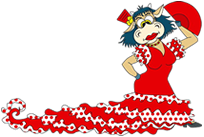-
Wiki
-
Technique of the right hand used for the Spanish guitar, the opposite of the "punteado". Basic of the flamenco guitar.
-
When we applied the "alzapua" technique to the whole hand, with "tresillos" executed with the index finger and the big toe.
-
The knocks are double and done with the whole foot.
-
To understand this concept we have to imagine a watch with the numbers 1 to 12.
We keep the 1, the2, the 3, the 4, the 5, the 6, the 7, the 8, the 9, the 10, and we show the 11 as the 1 and the 12 as the 2.
Now we visualize the imaginary watch and we trace a line from the 12 (like the 2) and to the 6. The right side is called 6/8 and the left side the 3/4, and the imaginary line is called the accent.
The right side of the circle corresponds to the six times of a 6x8 compas, with accents on 12 (2) and on the 3, dividing the six times in two groups of three, 2-1-2 and 3-4-5.
The left side shows the six times of a 3x4 compas, with accents on the 6, 8 and 10, divided in three groups of two: 6-7; 8-9; 10-11 (1).
To count the twelve times of a flamenco compas we use the flamenco watch, it will help us to understand the rhthmical structure, it is like a rhythmical regulator. -
Rhthmycal, melodic or harmonical cadence in the flamenco music. Last tercio/part, we usually accelerated the time and we changed the modal tone for the Major. We also know this culmination like macho or cambio, with a clear musical structure.
-
This is a widespread experience: at the end of each "coplas" session (three or four, the ones sung in a row, after that they experienced small breaks) each dancer or "bailaoe" had the right to give a "ritual hug" to his "bailaora". It usually was a simple gesture: to lay arms on the "bailaora" shoulders, or a similar gesture.
When the hug was more demonstrative than the conventions allow, some of the observers reprimanded the dancer. The ending varied, from laughs in the best cases to fights with knife wounds and even deaths. -
Song, also known as "corrido" or "corrida", with a very special intonation, based in the popular Andalusian Romances. Interpreted without accompaniment, possibly the most primitive flamenco style.
-
Flamenco song from the group of the Cantiñas, Cadiz. Romero el "Tito", popular Andalusian cantaor from XIX. century created from an old Cantiña a danceable style and he called it Romera.
-
A flamenco palo coming from the city of Ronda, in Malaga. As the rest of flamenco palos coming from Malaga, the Rondeña is prior to the current flamenco.
It's a copla with four octosyllable lines, generally with a consonant rhyme. With or without repetition of the second line.
It's a composition without compas, the lyrics talk about the rural life. Now it's slower than before. -
Rumbas, they belong to the Latin American branch, to the tangos group and the measure is binary. "Aflamencado" songs belonging to the songs of "Ida y Vuelta". A musical rhythm like a dance style coming from Africa, through the slave trade to Cuba. The rumba arrived in Spain with the flamenca rumba and the Catalonian rumba. Connected to the "guaracha" more than with the Cuban rumba.
Three different "tumbadoras":
El Guaguancó, (La Habana)
La Columbia, (Matanzas)
El Yambú. (Matanzas)












